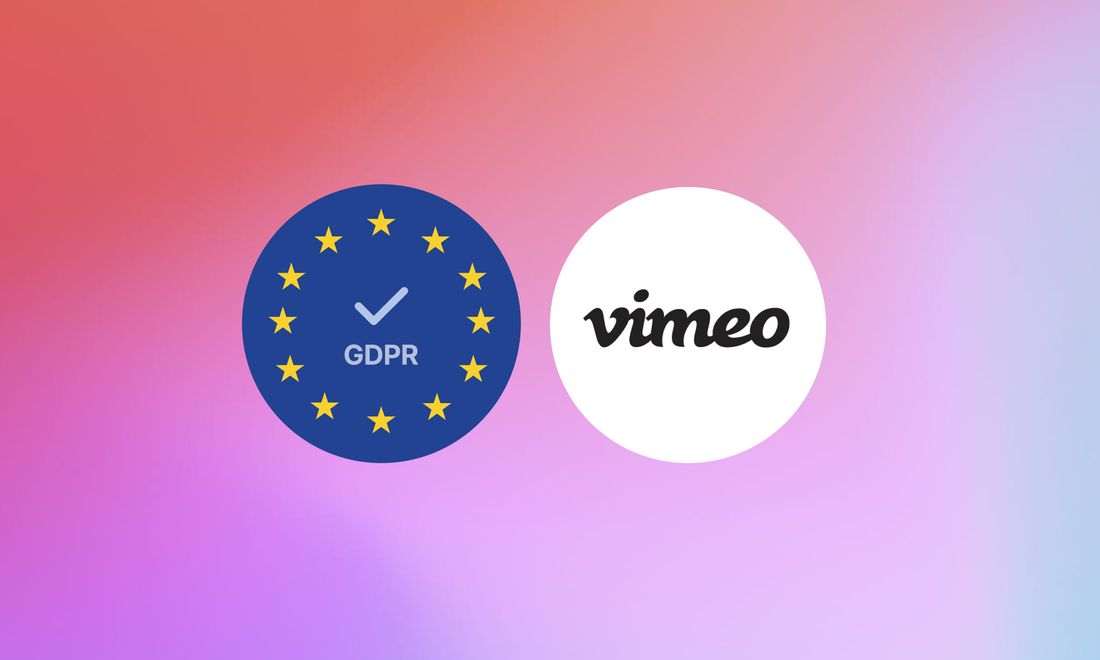
Embedding Vimeo GDPR-compliant: A comprehensive guide
The use of Vimeo as a video hosting platform is widespread – whether for marketing purposes, tutorials, or promotional films. Vimeo has rightfully earned its reputation as a professional video tool.
However, for website operators in Europe and Germany, Vimeo, as a US-based provider, presents unique challenges. This guide explains why Vimeo poses issues concerning GDPR compliance, outlines the legal requirements, and provides practical solutions to help you integrate videos in a privacy-compliant manner.
Why Vimeo is a Challenge for GDPR Compliance
Vimeo is a convenient solution for embedding videos on your website. Theoretically, you just upload the video, copy the code, paste it on your website, and you’re done. Theoretically.
The GDPR makes things a bit more complicated for website operators. This is mainly due to the following reasons:
- Tracking of Personal Data: Vimeo collects data about user behavior as soon as a video is embedded on a website – even if the video isn’t played.
- Data Transfer to the USA: Vimeo stores and processes data on servers in the USA. Despite certification under the EU-U.S. Data Privacy Framework, legal risks remain. Vimeo does not guarantee EU hosting, nor is there an option to pay for it.
- Cookie Use Without Consent: Vimeo sets cookies by default, which violates GDPR if user consent isn’t obtained.
- Not an “Essential Service” and Requires Consent: According to data protection experts, Vimeo is not considered an essential service because its use is mostly optional and not a core function of a website. Dr. Sebastian Kraska explains: “Since embedding Vimeo is not necessary for the operation of the website, its integration requires user consent.” (We translated this quote from German to English. Source: Legalweb.io)
The same problems apply to YouTube – except that Vimeo doesn’t have a massive ad business in the background creating profiles of your website visitors. That’s something, at least.
Disclaimer: Whether and to what extent using Vimeo poses risks for your website must always be assessed by your data protection officer. We can only offer non-binding recommendations here.
Legal Requirements for Using Vimeo
The GDPR requires you, as a website operator, to protect the personal data of your visitors. Failure to comply can result in warnings or fines. When using Vimeo, you need to consider the following points:
- Obtain Consent: Vimeo uses tracking technologies that are only permitted with prior user consent. A cookie banner that clearly requests consent is essential here.
- Update Your Privacy Policy: Inform visitors about which data Vimeo collects, why it is transferred, and how it is processed. This information must be included in your privacy policy.
- Technical Safeguards: You can minimize the data sent to Vimeo by adding parameters like dnt=1 (see below). However, this alone is not enough to fully comply with GDPR.
This also means:
If your visitors do not consent via the cookie banner, you cannot load the Vimeo video – not even a preview. You must use a cookie overlay and only load the video after consent is given.
Unfortunately, many websites mistakenly assume that this can be circumvented using the “Do Not Track” mode. But we’re sorry to say: that’s not the case.
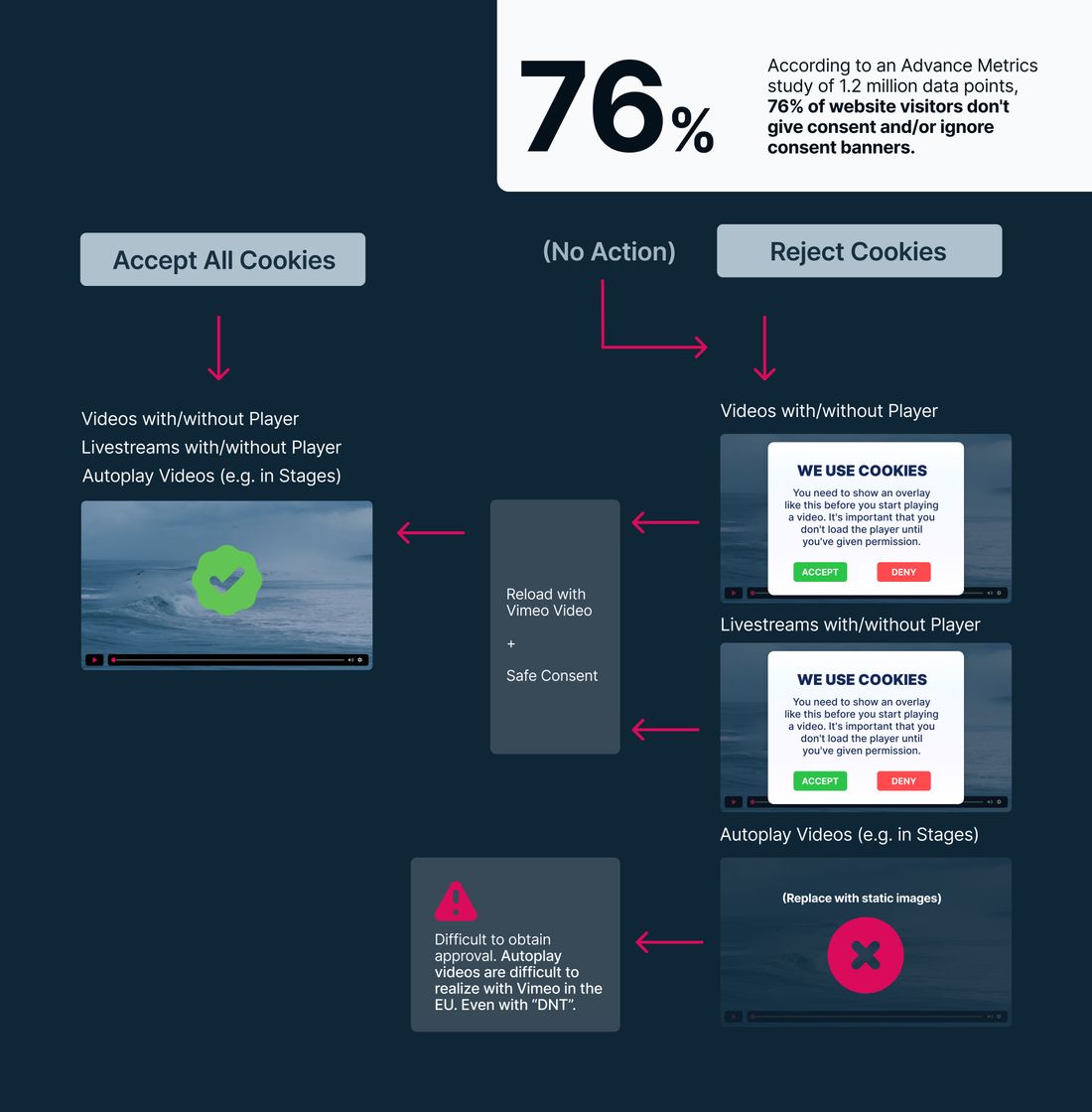
The Do-Not-Track Mode on Vimeo and Its Issues
Many people mistakenly believe that Vimeo’s Do-Not-Track mode provides a GDPR-compliant way to embed Vimeo videos.
What is the Do-Not-Track Mode (DNT)?
Vimeo explicitly offers this feature to reduce tracking of users on websites. When the DNT mode is enabled, the service is supposed to avoid collecting information about user behavior when they view embedded videos. The goal of this function is to enhance privacy.
However, while this mode reduces the amount of transmitted data, it does not entirely prevent cookies from being set. Bummer.
According to Vimeo’s own documentation, the following cookies may still be set when the DNT parameter is applied:
“If you apply a DNT parameter to the player, the only cookies that will be set are player_clearance, cf_clearance, _cf_bm, and _cfuvid, ...”
While this reduces the scope of tracking, it does not eliminate it entirely, which means further measures are required for GDPR compliance.
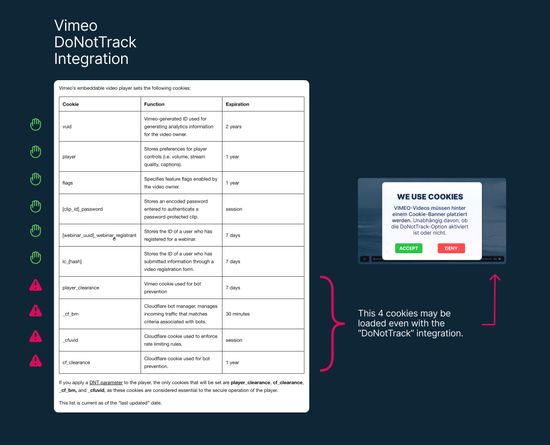
These Cookies Are Not Always Set. It’s unclear when and under what conditions these cookies are stored. For you, this means that while the Do-Not-Track mode is a helpful addition, it can never fully replace a clear and GDPR-compliant consent solution. In other words, you still need to obtain user consent to stay GDPR-compliant.
How to Use the Do-Not-Track Mode
Here’s a step-by-step guide.
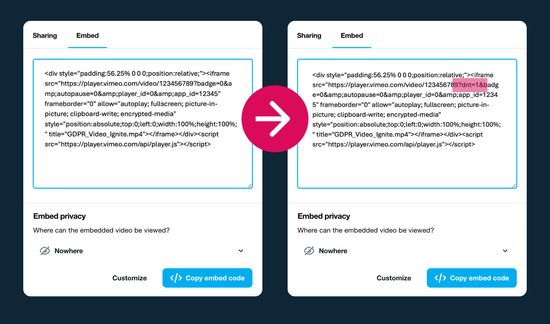
In short:
- Adjust the Embed Code Open the HTML embed code of the video and add the parameter dnt=1. Typically. Important: Don’t Remove Anything Else Make sure not to remove any other parameters in the URL, as they contain important information about the video’s settings.
- Do-Not-Track Mode Alone May Not Be Enough As mentioned earlier, the Do-Not-Track mode likely won’t suffice on its own. You still need to follow the additional steps outlined above, such as updating your privacy policy and ensuring full compliance.
For visitors who don’t provide consent via your website’s cookie banner, you should hide the videos to stay on the safe side. This can be particularly challenging for “decorative” videos, such as those autoplayed on hero sections. Unfortunately, Vimeo (and YouTube) don’t offer easy solutions for this scenario.
Overview: Options for Privacy-Friendly Integration of Vimeo Videos
There are several strategies to embed Vimeo videos in a GDPR-compliant way. Here are the most important options to help you minimize legal risks:
- Use the “dnt=1” Parameter See this Tutorial on DoNotTrack.
- Implement a Two-Click Solution With a two-click solution, Vimeo videos are only loaded after users explicitly give their consent. Users first see a preview image and must actively click “Show Video” before the content is loaded. There are numerous plugins for WordPress and other CMS platforms that can help you implement this. These plugins block videos by default and only retrieve Vimeo content after user consent. Examples include “Complianz” or “Borlabs Cookie.” It’s crucial that videos are only loaded after consent has been granted. With standard integration, data is often transmitted to Vimeo even before a video is played. Not cool – it definitely costs you some views.
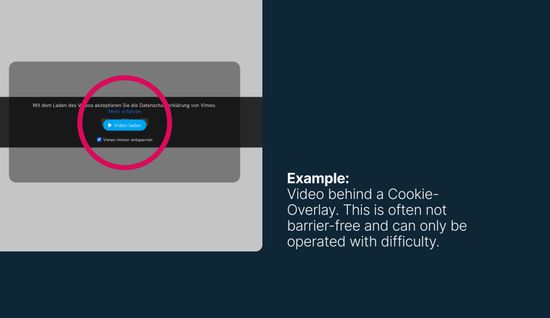
- Linking Instead of Embedding Instead of embedding Vimeo videos directly, you can use external links. This method avoids any data transfer to Vimeo unless users actively click on the link. Not the most exciting option, but it gets the job done.
Checklist: Integrating Vimeo in Compliance with GDPR
Let’s be clear: Vimeo can be GDPR-compliant.
You just need to follow these steps:
- Use a two-click solution or plugins that only load Vimeo videos after user consent.
- Ensure your privacy policy includes all relevant information about Vimeo.
- Check your cookie banner to make sure it properly asks for consent for Vimeo. (Reminder: Vimeo is not “essential” and must not be pre-selected.)
- Do not display videos without explicit consent – either through the initial cookie banner or a two-click solution.
- Optional but recommended: Add the dnt=1 parameter to the embed code.
Not Exactly Ideal: Are There Alternatives?
Videos that are only shown to a portion of your audience or require a few clicks to start cost you views. That’s unfortunate, considering how expensive and time-consuming video production often is.
To be honest: You’ll encounter the same issues with all major providers, especially those based in the US. YouTube? Same story. Wistia? No different. Everywhere you look, videos need to be hidden behind consent banners. GDPR compliance in Germany and the EU is no walk in the park.
Three Alternatives
1. Self-Hosting
This solution gives you maximum control over your data. With the right video formats optimized for the web, it’s a functional option. However, self-hosting is neither scalable nor high-performing. Key features like adaptive streaming, increasingly critical for mobile users, are typically absent.
2. Custom Video CDN
You can set up your own dedicated video servers. This is a premium solution for large websites, but it comes with significant costs for both setup and ongoing operation.
3. Ignite Video
We’ll be honest: We used to rely on services like Vimeo for our websites, but we were always frustrated with these issues.
30–60% of visitors unable to view videos? No way.
That’s why we developed Ignite Video:
- Privacy First
- Hosted entirely in Europe (Germany)
- No cookies & consent requirements
- No overlays
- Autoplay? No problem
- Accessible Video Player
- Videoplayer that fits to your brand
With Ignite, you can upload your videos and embed them on your website as you see fit. All you need to do is add us to your privacy policy. That’s it. Give it a try!
Example: Best Of Content Marketing Replaced Vimeo with Ignite
In this before-and-after example, you can clearly see the direct difference between the two integrations.
With Vimeo, users often encountered consent banners, tracking issues, and slower performance. After switching to Ignite, the integration became seamless, with:
- No tracking or cookies
- No consent banners required
- Faster load times and autoplay functionality
This switch not only improved the user experience but also ensured GDPR compliance without sacrificing accessibility or views. A clear win for both the website and its audience!
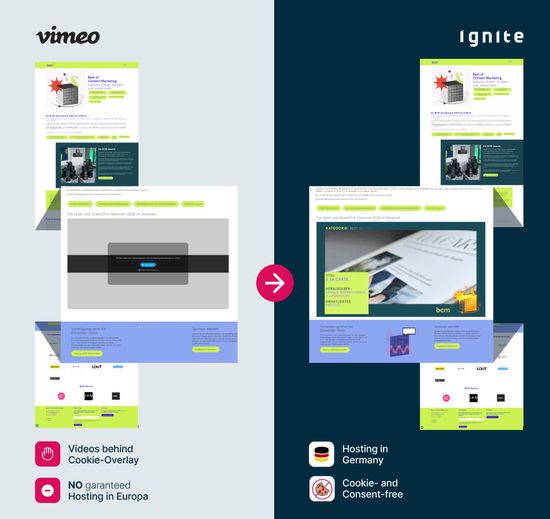
FAQ: Is Vimeo GDPR-compliant – and what are your options?
Let’s recap what really matters if you want to embed Vimeo videos on your website in a privacy-compliant way.
Is Vimeo GDPR-compliant?
By default, it’s not. Vimeo sets cookies and processes user data the moment a video is embedded - even if it isn’t played. That creates clear legal risks under the GDPR. Without prior user consent, Vimeo videos can’t be embedded legally on most European websites.
What does Vimeo’s “Do Not Track” mode actually do?
The DNT mode reduces some tracking but doesn’t eliminate it. Vimeo still sets sometimes technical cookies even when DNT is active. So while it’s a useful feature, it doesn’t make Vimeo GDPR-compliant on its own. You still need a consent mechanism.
Can I show Vimeo videos without a cookie banner?
No. Since Vimeo is considered non-essential, consent is required before loading any content. If users don’t agree via your cookie banner, you’re not allowed to show the video – not even a preview image.
What’s the point of a two-click solution?
A two-click solution ensures that no data is transferred to Vimeo until someone clicks to activate the video. The first click gives consent, and only then does the video load. This setup is necessary to meet GDPR requirements and can be implemented via tools like Complianz or Borlabs.
Is linking to Vimeo safer than embedding it directly?
Yes. If you only link to a Vimeo video, no data is transferred until someone clicks the link. It’s not very elegant, but it avoids the need for consent or overlays. (Hint: use Ignite)
What do I need to do legally if I still want to use Vimeo?
You must show a consent banner, block all Vimeo content until consent is given, update your privacy policy with full transparency, and optionally activate DNT mode.
What are the GDPR-friendly alternatives to Vimeo?
Self-hosting gives you full control but lacks scalability and professional features. Custom CDN setups are powerful but expensive and complex. Ignite offers the practical middle ground: full European hosting, no cookies, no need for consent banners, and simple integration with autoplay and accessibility out of the box. Over 35 verified customer reviews on OMR, OMT, G2, and Capterra speak for themselves.
So, can Vimeo be used in a GDPR-compliant way?
Yes, but only if you implement clear consent mechanisms and update all legal texts on your site. And even then, you may still lose views. That’s why many teams switch to Ignite – to skip the legal complexity and deliver videos that just play.
Sounds interesting?
Then you can try all Ignite features for 30 days completely free of charge. No up front subscription, no need for payment details. Of course, we can also schedule a personal demo to show you what's possible with Ignite.


